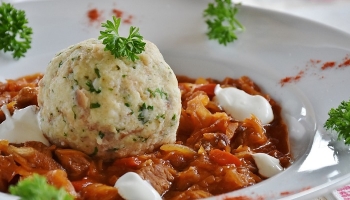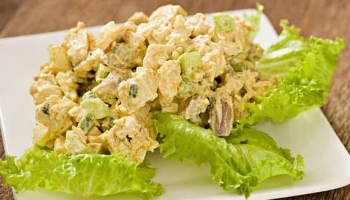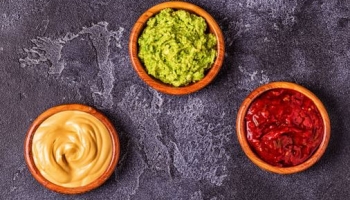Eggs may be nature’s most perfect food. Designed to provide the developing chick with all the nutrients it needs, eggs contain protein, healthy fats, and even a very low amount of carbohydrates.
(With 80 calories, 6 grams of protein, and 0.6 grams of carbohydrates, eggs are the original low-carb food!)
Most of the fat is polyunsaturated and monounsaturated, making it healthier than typical saturated animal fats.
Eggs are also a great source of choline, Lucine, Vitamin D, and two B-complex vitamins useful for energy metabolism. Free-range and flax-supplemented hens produce eggs even higher in healthy Omega-3 fatty acids.
Goose eggs, duck eggs, and quail eggs may be locally available and are a fun alternative to chicken eggs. They’re generally all prepared the same way, although the size difference may lead to differences in cooking times.
Table Of Contents:
- Cooking Eggs On An Induction Cooktop
- Frying An Egg on an Induction Stove
- Perfectly Poached Eggs
- Cooking an Omelet on an Induction Range
- The Best for Last: Scrambled Eggs on an Induction Cooktop
- How can I tell how fresh an egg is?
- How can I tell if an egg is hard-boiled?
- Is it “omelet” or “omelette?”
- Conclusion
Cooking Eggs On An Induction Cooktop

Induction ranges are different from your standard-issue thermal (hot) stove. Traditional stoves use electricity or natural gas to produce heat, that is conducted to your cookware, that is conducted to the food.
Induction stovetops use electromagnetic currents to conduct magnetic energy to the cookware, which then heats up from that energy and conducts that heat to your food.
Because they work via electromagnetic induction, induction stoves require magnetic cookware, such as stainless steel or cast iron. Aluminum pots and pans, while incredible on their own, do not work with an induction cooktop.
(That said, read the product description, because an aluminum pan can be made induction-ready by adding a magnetic plate to the construction of the cookware.)
In order to produce the best possible meals, we suggest investing in high-quality cookware. Curtis Stone Cookware Company makes excellent products, though as usual, their aluminum pans are not induction-compatible.
back to menu ↑
Frying An Egg on an Induction Stove
In order to fry an egg, you’ll need induction-ready cookware, a spatula (rubber or silicone, please), a small bowl, and the egg. If your pan is nonstick you may not need butter or oil, but if you’re frying an egg, you really do want at least some fat–about a tablespoon per pan.

Please note that anywhere we say “butter,” the Hello Fresh garlic herb butter can always stand in as a replacement.
For 1-2 eggs, an 8-inch pan is ideal, but for 3-4 eggs a 12-inch pan is ideal. Crack each egg into a bowl first–it makes the entry into the pan more gentle, keeping the egg tighter and more shapely. It also reduces splatter and allows you to start all the eggs at approximately the same time.
(I like a runny yolk and my husband likes them fully cooked, so I put his eggs on the stove before mine to let them cook an extra few minutes.)
Melt the butter (or heat the oil) over high heat, until a drop of water dances and sizzles on the surface. Turn it down to medium, and add the eggs. Watch out for splatters!
In approximately 2 minutes, the white will be cooked while the yolk is still gooey. Gently shake the pan to see how solid the yolks are, and take them off the heat when they reach your desired “done-ness.”
Top with sea salt and cracked pepper. Suggested serving: over toast, so the bread can soak up the runny yolk. I also love a fried egg over a salad, because the yolk mixes in with the salad dressing in a delightful way.
back to menu ↑
Perfectly Poached Eggs
Poached eggs offer the same delicious combination of runny yolk with solid white as a fried egg, but are a healthier option since they’re cooked in water instead of fat.
The basic idea is, that you get water almost but not quite boiling (technically, poaching is best performed at 185 degrees Fahrenheit, while–remember–water boils at 212 degrees Fahrenheit).
You crack the egg into the water, it cooks, and you remove it 3-4 minutes later if you want a runny yolk, or longer if you don’t.
But this gives you an uglier end result (still tasty, though!). To make the poached egg more beautiful, we can add some vinegar to the water, or even crack the egg into a fine-mesh sieve, so the thinner and runnier bits of white drain off and don’t form ugly “feathers.”
If you’re serious about beautifully poached eggs, you can even swirl the water before you put the egg in–it helps to keep everything contained within a tight spherical white. Cooking one egg at a time makes them prettier; cooking multiple eggs at one time makes them faster.
Remove the egg from the water with a slotted spoon.
Restaurants will often “clean up” a poached egg with a knife to remove any feathers and make the whole thing more spherical. I eat them fast enough that I don’t care what they look like, so I put a lot less effort into my poached eggs. To each their own!
back to menu ↑
Cooking an Omelet on an Induction Range
As always, cooking top-notch eggs requires top-notch cookware, including non-scratch (silicone or rubber) spatulas. You’ll also need a bowl and whisk (or fork) for this recipe.
One remarkable thing about omelets is that it’s easy to customize the fillings. Cheese is the easiest, but grilled onions and mushrooms add an earthiness that I go crazy for.
Start with a two-egg omelet, as manipulating the whole thing gets trickier with more eggs–with two eggs, cooking is consistent and thorough. (I tried a six-egg omelet once, and when the bottom was burnt, the top was still raw.)
Crack the eggs into a bowl until fully combined–a fork or a whisk works perfectly. I salt and pepper now, but you can also do that at the end. Be sure to incorporate some air (that is, don’t just stir the eggs, but break the surface by lifting the whisk up and down) to make the omelet fluffier.
Melt the butter in an 8-inch skillet over medium-low heat. Once melted, add the eggs, and let them sit. Don’t stir them! An omelet is made of a flat sheet of egg, folded in half. If you stir it now, you’ll wind up with scrambled eggs.
As the edges start to set, you can gently push them towards the center to allow more liquid to spill over and start to set. Definitely don’t separate out large curds.
After about 5 minutes, put the fillings (pre-cooked, if necessary) down the center of the omelet and cook another minute or two, until the eggs are mostly set but still shiny in the middle.
Using the spatula, loosen the omelet from the pan as necessary. Slide it out onto a plate, folding it in half as you go (you may need a spatula in your second hand to guide the omelet’s folding).
Filling ideas include: mushrooms, onion, diced tomatoes, chives, sausage, and diced bacon–the possibilities are endless!
back to menu ↑
The Best for Last: Scrambled Eggs on an Induction Cooktop
In my opinion, properly scrambled eggs are one of the greatest delights of life on this planet. However, what makes them “properly scrambled” is a subject of great debate! The French like small curds, a scrambled egg that almost resembles oatmeal (it’s called Oeufs Brouilles). Mexicans stir in tortillas (chips or strips) and veggies to make Migas. Pakistan likes a crispy, crunchy scrambled egg known as Khagina.
This recipe is for stereotypically American scrambled eggs, with large, fluffy curds–top it with cheese, or serve bacon on the side.
As always, you’ll need eggs and an induction-ready nonstick fry pan from a brand like Ballarini. You’ll also need a bowl, whisk, spatula, butter, and some form of liquid fat: I use whole milk, but I’ve read some chefs swear by mayonnaise!
You’ll need about a quarter cup per egg, but this is very flexible. Play with different fats and different amounts until you know what you love.
Ok. Melt a tablespoon of butter in your best nonstick frying pan, and while it melts, crack two or four eggs in a bowl. Whisk them hard, and whisk in the fat–milk, half-and-half, mayo–until everything is very well incorporated. The more air you get in the egg, the fluffier the final product will be, so whisk, baby, whisk.
With the butter melted and the pan on medium-low, pour the whisked eggs into the pan. Wait. Count at least to ten before you touch them.
Then, slowly, use the rubber/silicone spatula to pull the curds away from the edge of the pan, working your way around the pan. The slower and less-vigorous the pushing, the larger and fluffier your final product. (So a French chef would stir constantly and vigorously to get those tiny soupy curds.)
When things are mostly solid but still shiny (i.e., still wet), add whatever cheese you want. We stir in shredded sharp cheddar, but goat cheese is also extraordinary.
Remove the pan from the heat before it looks done, as it will continue to cook in the pan until you plate it.
Frequently Asked Questions
back to menu ↑
How can I tell how fresh an egg is?
This is a great question because the freshness can make a huge difference depending on your recipe. When hard-boiling eggs, you want to use less-fresh eggs–at least a week or three old. Why?
Well, a fresh egg contains yolk, white, and a tiny little air bubble. As the egg ages, water evaporates through the eggshell, and the air bubble gets larger. With hard-boiled eggs, a larger air bubble makes for easier peeling. When frying eggs, though, the fresher the better!
So, how do we know how fresh an egg is? Labeled eggs from the grocery store are easy–check the purchase date or expiration date. Are your eggs not labeled? In that case: put the egg in a glass of water. Fresh eggs sink because they have minimal air pockets; old eggs float because they have more air.
back to menu ↑
How can I tell if an egg is hard-boiled?
Another great question, because cracking a raw egg when you expect a hard-boiled treat is… well, it’s awful.
So.
Spin the egg, on its side, like you’re spinning a top. Quickly stop it; then just as quickly, release your grip. A raw egg has liquid contents, so the inside keeps moving even when you stop the outside–the egg will move after the brief stop.
A hard-boiled egg is solid, so stopping the outside effectively stops the inside, and the egg will stop moving.
Take an egg you know is raw, and one you know is hard-boiled, and spin them both to get a feel for how they’re different–that’ll make it easier to tell in the future.
Option B is to label all your eggs, and only put hard-boiled eggs in certain spots or containers. Heck, get a pencil and label the egg shell itself–pencil is perfectly safe for eggs and their contents, even when consumed by humans.
back to menu ↑
Is it “omelet” or “omelette?”
The omelette was invented by the French, who originally spelled it that way. Omelet is the Americanization of that word. Today, they denote style, more than anything. A French omelette is traditionally rolled like a log, while an American omelet is traditionally folded in half.
Both are delicious.
back to menu ↑
Conclusion
To me, there is one clear-cut conclusion that every single one of us can act on: eat more eggs, more often, cooked well. Eggs are so incredibly flexible that nearly everyone can find a way to prepare them that they like–four of the best options were presented here, today.
Remember to use fresh eggs, rubber or silicone spatulas, and the best induction-ready cookware you can afford.
Shanny
Shanny not only has an exceptional understanding of the foodie mindset and how nutrition works, she has also achieved her Master’s Degree in Education. Outside of her academic achievements, she loves writing food blogs. It's so much more than a list of meals though! Shanny creates helpful cookware guides and delicious recipes that are easy to follow. She does all of this as a food blog writer because she loves it. That's why she spends lots of time testing out different recipes in her own home. She truly is a one-of-a-kind foodie, from her home to yours - with a story to tell, new recipes to indulge in and new tips to tantalize those tastebuds.












